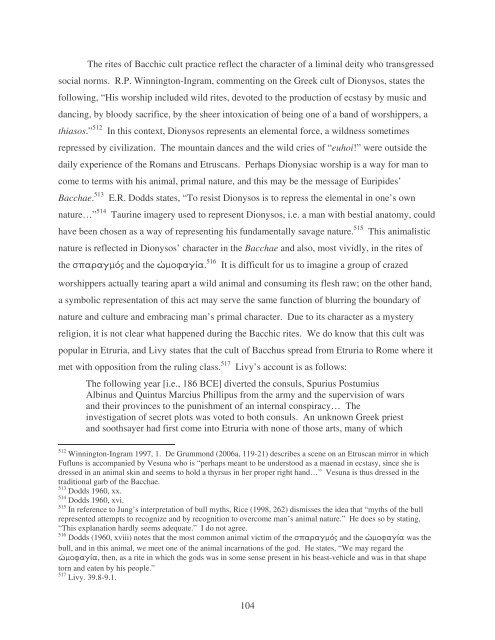Final Draft - Preview Matter - Florida State University
Final Draft - Preview Matter - Florida State University
Final Draft - Preview Matter - Florida State University
You also want an ePaper? Increase the reach of your titles
YUMPU automatically turns print PDFs into web optimized ePapers that Google loves.
The rites of Bacchic cult practice reflect the character of a liminal deity who transgressed<br />
social norms. R.P. Winnington-Ingram, commenting on the Greek cult of Dionysos, states the<br />
following, “His worship included wild rites, devoted to the production of ecstasy by music and<br />
dancing, by bloody sacrifice, by the sheer intoxication of being one of a band of worshippers, a<br />
thiasos.” 512 In this context, Dionysos represents an elemental force, a wildness sometimes<br />
repressed by civilization. The mountain dances and the wild cries of “euhoi!” were outside the<br />
daily experience of the Romans and Etruscans. Perhaps Dionysiac worship is a way for man to<br />
come to terms with his animal, primal nature, and this may be the message of Euripides’<br />
Bacchae. 513 E.R. Dodds states, “To resist Dionysos is to repress the elemental in one’s own<br />
nature…” 514 Taurine imagery used to represent Dionysos, i.e. a man with bestial anatomy, could<br />
have been chosen as a way of representing his fundamentally savage nature. 515 This animalistic<br />
nature is reflected in Dionysos’ character in the Bacchae and also, most vividly, in the rites of<br />
the ( and the t M , . 516 It is difficult for us to imagine a group of crazed<br />
worshippers actually tearing apart a wild animal and consuming its flesh raw; on the other hand,<br />
a symbolic representation of this act may serve the same function of blurring the boundary of<br />
nature and culture and embracing man’s primal character. Due to its character as a mystery<br />
religion, it is not clear what happened during the Bacchic rites. We do know that this cult was<br />
popular in Etruria, and Livy states that the cult of Bacchus spread from Etruria to Rome where it<br />
met with opposition from the ruling class. 517 Livy’s account is as follows:<br />
The following year [i.e., 186 BCE] diverted the consuls, Spurius Postumius<br />
Albinus and Quintus Marcius Phillipus from the army and the supervision of wars<br />
and their provinces to the punishment of an internal conspiracy… The<br />
investigation of secret plots was voted to both consuls. An unknown Greek priest<br />
and soothsayer had first come into Etruria with none of those arts, many of which<br />
512<br />
Winnington-Ingram 1997, 1. De Grummond (2006a, 119-21) describes a scene on an Etruscan mirror in which<br />
Fufluns is accompanied by Vesuna who is “perhaps meant to be understood as a maenad in ecstasy, since she is<br />
dressed in an animal skin and seems to hold a thyrsus in her proper right hand…” Vesuna is thus dressed in the<br />
traditional garb of the Bacchae.<br />
513<br />
Dodds 1960, xx.<br />
514<br />
Dodds 1960, xvi.<br />
515<br />
In reference to Jung’s interpretation of bull myths, Rice (1998, 262) dismisses the idea that “myths of the bull<br />
represented attempts to recognize and by recognition to overcome man’s animal nature.” He does so by stating,<br />
“This explanation hardly seems adequate.” I do not agree.<br />
516<br />
Dodds (1960, xviii) notes that the most common animal victim of the ( and the t M , was the<br />
bull, and in this animal, we meet one of the animal incarnations of the god. He states, “We may regard the<br />
t M , , then, as a rite in which the gods was in some sense present in his beast-vehicle and was in that shape<br />
torn and eaten by his people.”<br />
517<br />
Livy. 39.8-9.1.<br />
104

















